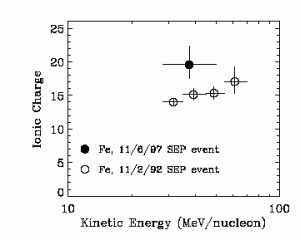New Measurements of High Energy Solar Particle Charge States
Using the MAST instrument on SAMPEX, we have measured the average charge state of iron at energies of 28-50 MeV/nucleon in the November 6, 1997 solar energetic particle (SEP) event. This measurement was made by finding the latitude distribution of particles and relating it to the geomagnetic cutoff rigidity which, together with the measured=20 mass and energy, gives the mean particle charge state. This approach works to identify charge states at energies much greater than can be measured using electrostatic deflection techniques such as on the ACE SEPICA instrument. The approach requires a satellite in a polar Earth orbit such as SAMPEX, and was first used successfully in the the SEP events of 10/30/92 and 11/2/92.
Although the statistical accuracy was more limited in the 11/6/97 event than in the 1992 SEP events, it is clear from the accompanying figure that the charge state of Fe is significantly higher in the 1997 event than in the 1992 event. This was also the case at lower energies of ~1 MeV/nucleon, as determined using the same technique with the LICA instrument on SAMPEX. In addition to demonstrating that the average charge states can vary greatly from event to event, the combination of MAST and LICA data also indicate a much stronger energy dependence of the charge states than was observed in the 1992 events.
Charge state measurements are important for understanding the origin of the observed particles. Although other ionization mechanisms are possible, charge states are usually interpreted as being indicative of the temperature at the source region. Higher charge states, which indicate higher temperatures, suggest we may be seeing material from the flare site itself (Q[Fe]=18 > T ~ 7 MK), while lower charge states and temperatures may indicate accelerated coronal material (Q[Fe]= 15 > T ~ 2 MK). In addition, the composition of the arriving particles may be very different from that of the source material, if the acceleration or transport mechanisms operate with different efficiencies depending on the magnetic rigidity of the particles, which scales as the ionic mass to charge ratio, Q/M. In the SEP event examined here, large elemental and isotopic fractionation was observed using the Solar Isotope Spectrometer (SIS) on the ACE spacecraft. Charge state measurements of particles at similar energies, such as only SAMPEX can presently provide, are critically important for gaining understanding of the processes involved in the fractionation observed by ACE.
Analysis of MAST data in other SEP events since the November 1997 events is ongoing. Although one of the position detectors was noisy enough that it had to be turned off in late 1997, all 4 PSD’s have been performing well since August of 1998, restoring the instrument to its full capabilities for SEP measurements. Thus MAST data should continue to provide an important complement to the SEP composition.
Contributed by Rick Leske, Caltech
«Return to the Results page
